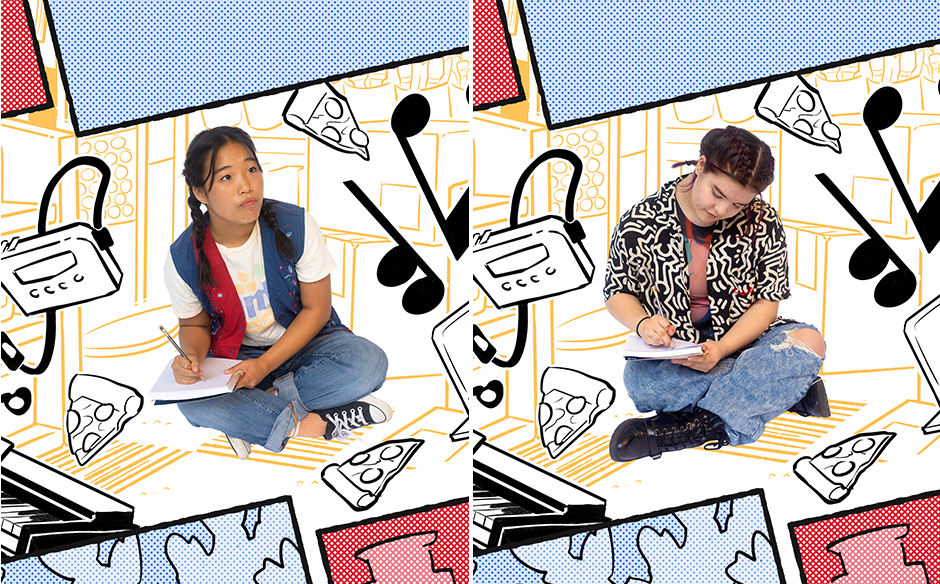The core takeaway from “Drawing Lessons” is anyone can draw.
Set during the 1995-1996 school year in Minneapolis, “Drawing Lessons” focuses on 11-year-old Kate, a budding artist. Over the course of the play, Kate finds her artistic voice through an unlikely mentorship with a comic strip artist and reconnects with her Korean identity through bonding with her great aunt via art.
“Drawing Lessons,” co-commissioned by Ma-Yi Theater Company as well as Children’s Theatre Company as part of Generation Now, a multi-theater project by Children’s Theatre Company, is set to open for previews in Minneapolis on Oct 8. The play seeks to “diversify the canon of children’s theater,” said the play’s director, Jack Tamburri, by commissioning new plays from artists and theaters of color.
“Drawing Lessons” is not only about art but includes it in the form of live drawing performances by the actors themselves, along with projected artwork by Minneapolis-based graphic novelist Blue Delliquanti, author of graphic novels “Across a Field of Starlight” and “O Human Star.”
Why comics?
“One of the things that we really hope to do (with the play) is pull people into the world of a graphic novel using the strategies of the graphic novel, but for the stage. Our hope is that for people who are familiar with the form, it will feel both familiar and new – an exciting interpretation of what it is to be inside a graphic novel and also inside the creative process of making comic art,” said playwright Michi Barall.

Delliquanti was approached for the project via the Minneapolis College of Art and Design, where they are an instructor. The project, they said, has allowed them to be a part of a more collaborative process, which has been “a refreshing change of pace.”
“Theater by nature is a very collaborative space,” said Delliquanti. “I’m working with a projection manager who is responsible for getting my work projected and (for) transition(ing) from image to image in a really cool, sophisticated way. My work would not be displayed the way it is without (Elizabeth Barrett’s) work. There’s working with the actors themselves who don’t consider themselves experienced artists when it comes to drawing, but (who) are really great to work with in terms of getting them to feel comfortable drawing live. They’ll draw live and those drawings (will be) projected to the audience.”
As a graphic novelist, Delliquanti was also able to provide the production with necessary historical context concerning the comic industry.

“I’m 35 (years old), so I was also a child when the mid nineties (and) late nineties were happening,” said Delliquanti. “That was when the comics scene in North America was going through a lot of big changes or big changes were just about to come down the pipe. This was around the time that comics and graphic novels started being legitimized as works of literature. You have your Art Spiegelman (author of “MAUS”) (and) your Chris Ware (author of “The Acme Novelty Library” series). A little later on, Raina Telgemeier (author of “Smile”) would be a huge name in comics. This is around the time that comics from Japan and Korea started being imported in greater volume and that started changing how young comic readers would draw and think about comics as a medium. I provided some context for what sort of changes might be happening. I also provided some suggestions for drawing exercises that a budding artist might receive from a mentor and what would allow her to change and develop her style with practice.”
Reconnecting with identity
“Drawing Lessons” is described by Barall on its Children’s Theatre Company webpage as a “love letter to Minneapolis and its diversity.” Barall set the play in Minneapolis because longtime collaborator Matthew Park, who plays Kate’s father Matt grew up in Minneapolis. The multicultural nature of Minneapolis also allowed her to tell a story of how the children of immigrant communities navigate their identities.
“I wanted to highlight the kind of friendships and solidarities among communities of color and kids of color who find each other often in school spaces. The character of Lia is Hmong American, since there’s a significant Hmong population in Minneapolis, and the character of Omar is written as Somali American. He’s traveled more and (his family came) through London to Minneapolis,” said Barall of her characters.
In an earlier draft, the play featured a heritage day event where kids would share elements of their culture at school, such as food or traditional dress. While that scene is no longer in the play, the question of whether or not to assimilate into and/or how to adapt to a dominant culture remains part of the story.
“The larger culture is trying to make space for kids coming from all over, but is also struggling to figure out how or whether to assimilate them. And the kids are also having the same question of ‘How assimilated do I want or need to be in order to function?’ I wanted to interweave those stories, because I didn’t want it just to be Kate’s story, or to feel like Kate was having to navigate that space by herself because I think a lot of us see our experiences in other families,” said Barall.
This journey looks different for each actor playing Kate, as a result of the actors’ own different racial identities.
“We have two (actors playing Kate) – one is biracial (Mars Niemi) and the other is Korean American (Olivia Lampert), although she’s also an adoptee. The two Kates are written slightly differently in the text to highlight their experiences of trying to grapple with what it means for them (to be Korean American), particularly ’cause their dad came to America as a young person to study in the U.S. (and) he has a much stronger connection to a kind of Korean identity. (Kate’s) trying to reconcile the expectations that her father has of her (and) that her father has in relationship to what immigrant success looks like. What it means to define yourself in relationship to American identity. There’s a kind of disavowal at the beginning of being Korean and then a gradual embrace of the pieces of her and the parts of her that respond to elements of the culture and that feel true to her,” explained Barall.
Part of Kate’s embrace of her identity comes in the form of her great-aunt, Gomo, introducing her to Korean comics, or manhwa.
“For (Kate), there’s something intuitive about the form (of manhwa) that helps shape not just her, racial identity, but also her aesthetic sense and aesthetic identity – how she wants to make art and what she wants it to look like,” said Barall. “We wanted to give her that experience of what it feels like to feel that your racial identity and historical identity line up in a way that feels cool.”

Park, himself, finds the play resonant of his own experience growing up mixed race in Minneapolis, especially when he watches Niemi play Kate.
“Acting with an actor that’s mixed race is such a privilege because I rarely get to do it,” said Park. “There’s a scene where the character Gomo (Kate’s great-aunt) is telling Kate about how her mom wasn’t really good at Korean, but (the family) accepted her even though she didn’t speak Korean. That was similar to my mom’s story. When my mom first met my grandma, (my grandma) shook her hand and then went into the other room and cried and played piano. She was like, ‘My son is dating a white lady.’ I heard this story after my grandma had died, but I didn’t know this when she was alive, ’cause my grandma and mom were so close. My mom was completely accepted into my dad’s family, and she actually speaks more Korean than I do just, ’cause she had to, in that family. Seeing Gomo with (Niemi as Kate), just seeing them interact is eerily familiar to me.”
Mental health
The play also explores how art provides Kate – who struggles with public speaking and being overwhelmed by her senses – a means to communicate through her anxiety.
“We communicate (Kate’s) experience through all sorts of stage devices, including the way we treat the sound and lights in moments where Kate’s anxiety is particularly heightened, where she’s having a panic attack,” said Tamburri.

Kate’s struggles are not specifically named as a consequence of the play’s setting in the 1990s.
“We have a framework (now) for talking about anxiety, about sensory processing (and) about disability in some way (that we didn’t have then),” said Barall.
“One of the things that I wanted to do was to see what happen(s) if you put a very quiet character at the center of a drama,” said Barall. “Drama’s really talky, but you can (put a quiet character at the center) in a graphic novel because you’re really relying on the image to communicate and you can hear the character’s thoughts through the thought balloon. For me it was this interesting challenge of ‘What if you put someone who’s shy on stage, who struggles to talk to new people in new spaces? And what if we see that as a strength as opposed to some kind of deficit?’”
Within the play, Kate doodles to shut out an outside world that can be overstimulating and cause her stress, but this is misinterpreted by her social studies teacher as an unwillingness to engage or use her voice – as something to be fixed or changed. But there are different forms of intelligence, said Barall. For Kate, her quietness lends itself to a skill in observing the world around her.
“Americans tend to really overvalue extroversion. We think extroverted people are smarter, we think they’re nicer, we think they’re funner. This isn’t true in East Asian cultures. So I wanted to look at the kind of cultural dissonance within that and the cultural evaluation of introversion versus extroversion,” said Barall.
Kate isn’t the only character in the midst of struggling, either. Paul, the comic strip artist who mentors her, is also dealing with his own mental health.
“It doesn’t show up in the script so much anymore, but we understand that Paul is experiencing depression. His partner, John, is a touring actor with a Broadway show, so he’s out of town much of the time,” said Tamburri, adding that Paul is experiencing a creative block and his pet dog has passed away at the beginning of the play. “The two of them (Kate and Paul) encounter each other at a time when she is desperate for mentorship from a quiet voice that trusts her, who isn’t pushing her, but who is providing some pathways for her to explore. He is pretty desperate to be listened to, to be taken seriously (and) to be looked at as an artist. Her impression of him is that he is a successful creative person, and that sort of bolsters him.”
Their meeting sets the two of them, Tamburri says, on paths to needed confidence and wellbeing.
For Kate, meeting Paul allows her to “to explore alternative means of communication where she does have confidence, and ultimately to build some confidence in the area where she feels most afraid, which is public speaking.” By meeting Kate, Paul is “reminded of the imaginative openness of a young person. He’s reminded of a time in his practice when there was not the expectation of a daily gag and he starts to explore the creation of more personal work that doesn’t necessarily have a predetermined outcome.”
“Drawing Lessons” runs through Nov. 10.







